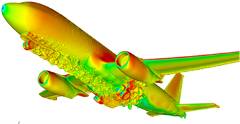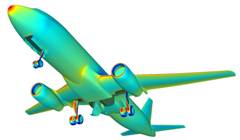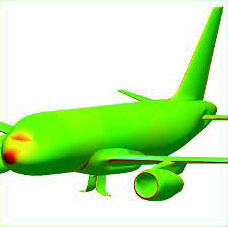CONTROL MEANS FOR VIBRATION AND AEROELASTIC COUPLING
Main expected results:
Engineering feasibility of noise and vibrations mitigation technologies proven by means of prototype demonstration in operational environment [TS6]
- Improve design and analysis from dynamic point of view (transient and aeroelastic response)
- Improvement of landing gear doors manufacturing process (new materials, new design principles)
Progress so far:
JANUARY 2016
Within the
scope of defining devices to reduce the vibration levels of the main landing
gear door, important steps towards flight test have been achieved.
All CFD calculations have been completed for the baseline
configurations covering different parts of the flight (take-off and approach)
as well as fully and partly deployed landing gear. Comparisons to flight test
data from previous tests show a good agreement to the numerical results.
Further insight will be possible, once the flights within AFLoNext have been
performed. The CFD and flight test data has been used to develop mitigation devices
in the landing gear area. Three sources for the main landing gear door
vibrations have been identified: the wake of the nose landing gear, the
interaction between the flow and the main landing gear door cavity and the
separation on the main landing gear door itself. Based on this knowledge,
several devices have been developed and are currently being assessed in terms
of practical feasibility and effectiveness.
The GVT on the main landing gear door has been performed and the data is currently being used to update the FEM. The updated FEM will allow a more accurate prediction of the door behavior during flight test as well as the assessment of structural mitigation devices.
The new monolithic nose landing gear door concept has been frozen. The new door consists of a stiffener panel concept made from monolithic carbonfibre prepreg.
APRIL 2015

JULY 2014
 On the CFD side, the aircraft, landing gear, cavity and door geometries have been successfully cleaned-up. Steady computations have been performed by most partners and first unsteady results are also already available. Two landing gear positions have been defined, one fully extended and one with the main landing gear bogey in the vicinity of the inboard main landing gear door. Two flight conditions have been defined, representing a typical landing and take-off case. The unsteady simulations will cover configurations with and without the nose landing gear, in order to determine the influence of the nose landing gear on the main landing gear inboard door vibrations. The first available unsteady results are for the configurations without nose landing gear and show low levels of unsteadiness. This suggests the nose landing gear to have significant contribution to the door vibration.
On the CFD side, the aircraft, landing gear, cavity and door geometries have been successfully cleaned-up. Steady computations have been performed by most partners and first unsteady results are also already available. Two landing gear positions have been defined, one fully extended and one with the main landing gear bogey in the vicinity of the inboard main landing gear door. Two flight conditions have been defined, representing a typical landing and take-off case. The unsteady simulations will cover configurations with and without the nose landing gear, in order to determine the influence of the nose landing gear on the main landing gear inboard door vibrations. The first available unsteady results are for the configurations without nose landing gear and show low levels of unsteadiness. This suggests the nose landing gear to have significant contribution to the door vibration.
The FE community has performed first calculations to ensure model conformity over all partners. Close cooperation is ongoing between the CFD and FE community to ensure a smooth transfer of results.
The planning of the GVT and FT is succeeding with the FTI being completely defined. The GVT will most likely be performed in January 2015.
Several designs for the monolithic nose landing gear door have been assessed and close cooperation with Airbus has been established to ensure a smooth certification of the new door for flight.
JANUARY 2014
 The geometry clean-up to get simpler geometrical shapes and watertight geometries for meshing and CFD calculations is ongoing and almost complete.
The meshing approach and number of meshes needed to satisfy the needs of all partners were also discussed and appropriate actions were placed. First numerical results on simplified aircraft geometries have been obtained by Kungliga Tekniska Högskolan and CFS Engineering SA, with the other partners following soon.
The following points have been discussed:
The geometry clean-up to get simpler geometrical shapes and watertight geometries for meshing and CFD calculations is ongoing and almost complete.
The meshing approach and number of meshes needed to satisfy the needs of all partners were also discussed and appropriate actions were placed. First numerical results on simplified aircraft geometries have been obtained by Kungliga Tekniska Högskolan and CFS Engineering SA, with the other partners following soon.
The following points have been discussed:


